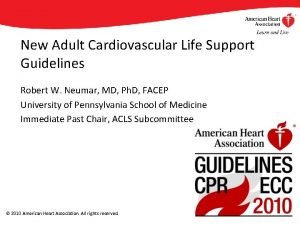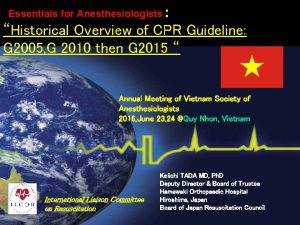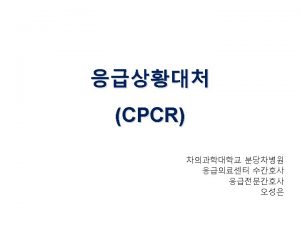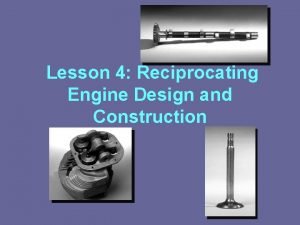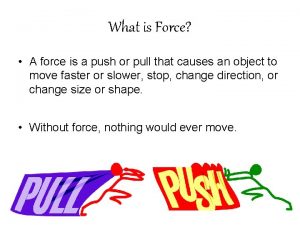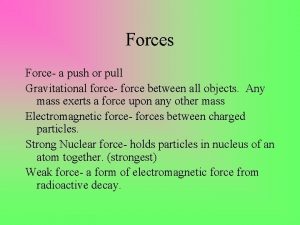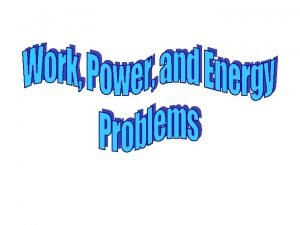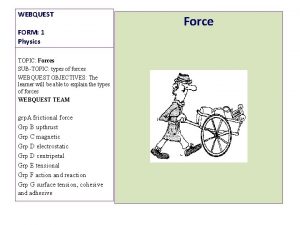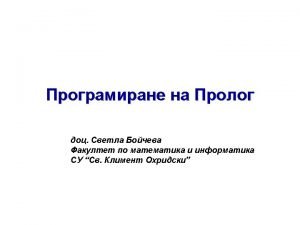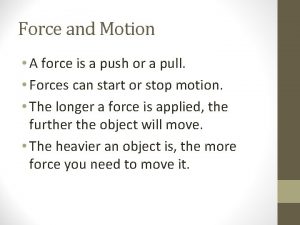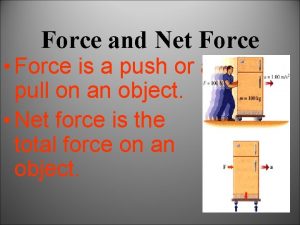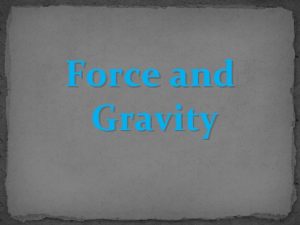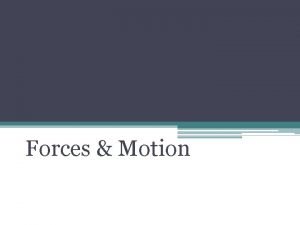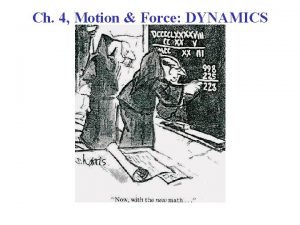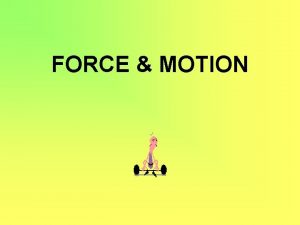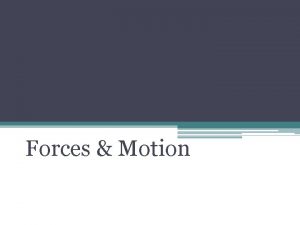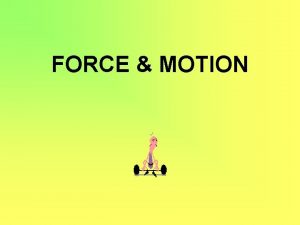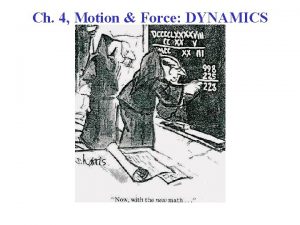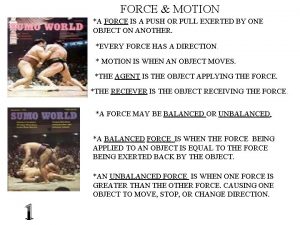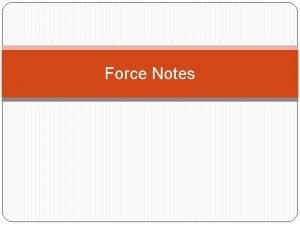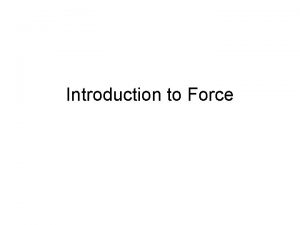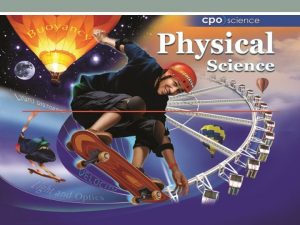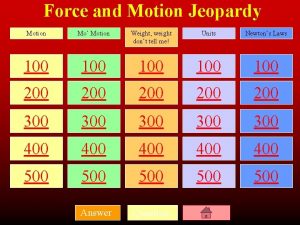Force and Motion a force is a push























- Slides: 23

Force and Motion: a force is a push or pull exerted on an object. The amount of force and the direction the force is applied will determine the motion of the object. F is a vector quantity while F is just the magnitude of the force and is a scalar quantity. System: the object that a force is acting upon is called the system. Everything around the object that exert forces on the object are called the external world. Contact Force: when an object from the external world touches the system and exerts a force on the system, the force being exerted is a Contact Force. Field Force: when an object from the external world exerts a force on the system without touching the system, the force being exerted is a Field Force. At this point in the class, the only field force that we will be interested in is Gravity. Agent: the thing that causes a force is called the agent. If a book is sitting on a table, what force(s) are acting on the book? What would be the system? What would be the agent? Air Resistance: the air around objects tends to slow down objects traveling through the air-this is because the molecules in the air have mass and momentum and need to be pushed aside to let the object pass. In this class we will usually ignore the impact of air resistance.

Practice: Identify the Forces, Systems, and Agents in each of the following situations. 1) A baseball pitcher throws a baseball toward home plate. 2) A car slams on the brakes and comes to a screeching stop as a child runs into the road. 3) A baseball player hits the ball that was thrown toward home plate.

Free-Body Diagrams: A pictorial model which illustrates the system and the forces acting on it is called a free-body diagram. By convention, forces are shown as arrows pointing in the direction that they are acting (the length of the arrows represent the amount of force). In addition, some indication of the positive direction is made off to the side of the diagram (such as +y with an arrow-the arrow pointing toward the positive direction). Practice drawing free-body diagrams for the following situations. 1) A girl throws a baton straight up into the air. 2) A boy slides down a slide on the playground. See additional Practice Problems on page 89.

Special Note: if forces are exactly balanced an object will either be motionless or will remain traveling in exactly the same direction with the same velocity. However, if forces are not balanced exactly, an object will either be speeding up or slowing down (assuming the force that is trying to cause motion is greater than the force that is holding an object stationary). Imagine the two situations below and use free-body diagrams to help determine what motion, if any, will occur. 1) A small boy pushes on a parked car. 2) A girl drops a rock off of a bridge.

Force and Acceleration: If a constant force is applied to an object, the object will accelerate (assuming that the force is great enough to overcome any forces that are resisting motion). Through experimentation, it is possible to determine that the amount of acceleration depends on two features. First, the amount of force acting on the object. Second, the mass of the object. The relationship between force, mass, and acceleration makes sense from our everyday experiences. If we throw a baseball softly, it will not travel very fast or very far. If we throw the baseball forcefully, it will go much faster and further. If we try to throw a watermelon, we will find that it will require a lot more effort to throw it as far or as fast as a baseball. So the relationships are: the heavier the object, the more force it takes to reach a given acceleration; the more force applied to an object, the faster it will accelerate. Mathematically, this relationship is given with the following equation: F = ma where: F is the net force applied to the object m is the mass of the object a is the acceleration of the object Remember that F and a are both vector quantities (but we will also work problems were we only focus on the magnitude of the force and acceleration).

Units of Force: from the equation F = ma, we can see that the units of force depend on the units for mass and for acceleration. The standard SI unit for mass is the kilogram (kg). The standard SI unit for acceleration is meter per second (m/s 2). Therefore: Force has units of kilogram meter per second (kg∙m/s 2) kg∙m/s 2 is also known as a newton (N) 1 N of force will give 1 kg of mass an acceleration of 1 m/s 2 Combining Forces: frequently, there is more than one force acting on an object. When there is more than one force acting on an object, the motion of the object will depend upon the “net force”. The net force is the vector sum of all the forces acting upon an object.

A horizontal force of 5 N is acting on a 2 kg object while at the same time, a horizontal force of -3 N is acting on the same object. Draw a free-body diagram for this situation and describe the acceleration of the object. A force of 15 N is acting to lift 25 kg object straight up. Draw a free-body diagram for this situation. Will the object move? If so, with what acceleration? See practice problems on page 93.

Newton’s Laws of Motion: First Law: An object at rest will remain at rest and an object that is moving will continue to move in a straight line with constant speed if and only if the net force acting on that object is zero. Said another way, an object at rest will remain at rest unless a force acts upon it. Or an object in motion will remain in motion unless a force acts upon it. Examples: An object that is sitting on a table will remain there unless some force pushes it. A rock dropped from a great height will continue to fall until some force stops it from moving. Second Law: The acceleration of an object is equal to the sum of the forces acting on the object divided by the mass of the object.

Inertia: Inertia is the tendency of an object to resist change in its motion. Inertia is a direct consequence of the Newton’s First Law of motion. What happens when you are driving in a car at 50 mi/h and you suddenly go around a sharp curve? Why do you feel like you are being pushed to the side? Does that “push to the side” mean that inertia is a force? What happens when you are in an elevator at the top of a tall building and the elevator suddenly starts to go down? Why do you feel like you are “lighter” than normal (or your stomach flutters)? Why does the feeling go away quickly even though the elevator is still going down? Equilibrium: When the net force acting on an object is zero, the object is in equilibrium. Does being in equilibrium say anything about whether an object is moving or not?

Please look at table 4 -2 on page 94 for a list of various types of forces commonly found in problems. It will be to your advantage to know these symbols and their meanings as you try to attempt problems throughout the class. Friction Ff a contact force that opposes sliding motion Normal FN a contact force exerted by the surface an object sits on Spring Fsp a restoring force-the push or pull of a spring on an object Tension FT a pull exerted by a connector that suspends an object Thrust Fthrust a force that propels an object Weight Fg a field force due to gravity

Weight and Mass have different meanings. Mass is the amount of matter present in an object (can think of it as being the total number of atoms or molecules present). Weight (Fg) however is the effect of gravity on matter. We can assign “g” to represent the acceleration due to gravity. When we do this, the equation F = ma becomes Fg = mg so that weight is clearly seen to be the force of gravity acting on a mass. Note that a scale (like a bathroom scale or a spring scale) is different from a balance. A scale measures the force of gravity acting on a mass (the weight), but a balance compares the mass of an object to a known mass (so it actually measures mass). This means that the mass of an object would be the same here and on the moon while the weight of an object here would be different from that object’s weight on the moon.

Example: if the mass of a bowling ball is known to be 3. 65 kg, what weight would be shown on a scale if we sat the bowling ball on a scale? First draw a free-body diagram illustrating the setup of the problem. +y . Fsp Notice that the forces are shown as acting from Click to see diagram the center of gravity of the object (the grey spot). Fg From the problem: mass = m = 3. 65 kg; acceleration due to gravity = g = - 9. 80 m/s 2 and we are looking for what the scale would read (Fsp). From the diagram, we see that Fsp = - Fg = - mg Click to see solution to the problem Plugging in: Fsp = - mg = - (3. 65 kg)*(- 9. 80 m/s 2) = 35. 77 = 35. 8 kg∙m/s 2 = 35. 8 N (note: in Physics the correct unit for weight is N and the correct unit for mass is kg) See practice problems on page 97.

Apparent Weight depends upon the acceleration due to gravity and mass. However, the acceleration due to gravity is not really constant. If we move far enough from the surface of the Earth, the acceleration due to gravity becomes smaller. If we were to travel very deep underground, the acceleration due to gravity becomes smaller as well (why? ). If we were on a different planet, the acceleration due to gravity could be higher or lower than here on Earth (what would determine whether it would be higher or lower? ). For this class, we will almost always assume that the acceleration due to gravity on Earth is constant (9. 80 m/s 2 toward the center of the Earth). Even if we assume that the acceleration due to gravity is a constant, there are still times when our weight would not be what we might expect it to be. For this reason, we use the term Apparent Weight in many situations. Apparent Weight (i. e. the force on the scale) is the weight we calculate when all of the forces acting on an object are taken into account. See practice problems on page 100.

Drag Force is the force exerted by a fluid (like air or water) on an object that is moving through the fluid. If you have ever stuck your hand out of the window of a car going at highway speeds, you have experienced drag force. Changing the speed of the car and/or changing the shape of your hand (fist or open hand) should let you understand that the drag force depends upon both the speed the object is moving through the fluid and upon the shape of the object. If you have ever tried to force your hand through water, then you have also experienced the other important feature of drag force. Drag force depends upon the properties of the fluid the object is moving through. Since water has particles much closer together than the particles in the air and the particles in water are fairly strongly attracted to each other, it is much more difficult to make the particles in water separate from each other to let you hand pass through. Therefore, the drag force through water is much greater than through air.

Terminal Velocity Terminal velocity is the constant velocity of an object when the drag force on an object is equal to the force of gravity acting on the object. While we will ignore wind resistance (drag force for an object moving through the air) for many problems, there are some very real situations where we can not ignore it. Imagine dropping a tennis ball from a great height. If we watch carefully, we can see that the ball eventually stops increasing its velocity. Why is this so? The fuzzy ball does not have much mass, and it has a lot of air resistance. Therefore, the drag force on the ball will become important when the ball starts to move fast enough. For some objects, the terminal velocity is quite fast, but for others, it can be very slow. Imagine dropping a cotton ball and a steel ball bearing. Even if we used equal masses of cotton and steel, the cotton ball would fall much slower than the ball bearing because it has a large amount of air resistance compared to the ball bearing.

Interaction Forces: Interaction forces are forces that act in pairs where the pair of forces are acting in opposite directions but have equal magnitudes. Such a pair of forces is called an Interaction Pair or an action-reaction pair of forces. If you have ever fired a gun, you have experienced such and action-reaction pair. When a gun fires, a small explosion will cause the bullet to accelerate and it will cause the gun to “kick” backwards. Why does the bullet end up going very fast but the gun only moves much more slowly? If the action-reaction pair of forces are of equal magnitude, why do the bullet and the gun behave so differently?

Imagine that the red and black boxes below are actually two people on roller skates. If the person in red suddenly pushes against the person in black, then a pair of actionreaction forces will be created. FBlack on Red FRed on Black Note that even though only one person did the pushing, two forces will be created. FRed on Black = - FBlack on Red Remember that F = ma. So m. Reda. Red= - m. Blacka. Black If the mass of the red is the same as the mass of the black, then both objects will accelerate equally in opposite directions. However, if the masses are different, then they will have different accelerations. Which mass will have a greater acceleration?

Newton’s Third Law: for every action there is an equal but opposite reaction. The definition above is Newton’s Third Law in common language. The more technical version is: The force A on B is equal in magnitude and opposite in direction to the force of B on A AB FB on A FA on B = - FB on A Example Problem: A softball that has a mass of 0. 18 kg is dropped. What will the force on the Earth be? What will the acceleration of the Earth be? The mass of the Earth is approximately 6. 0 X 1024 kg. FEarth on Ball = mg = (0. 18 kg)(- 9. 80 m/s 2) = - 1. 764 N FEarth on Ball +y FBall on Earth Click= 1. 764 N = ma to see solution FBall on Earth (1. 8 N)

Forces on Ropes and Strings: Tension (FT) is a specific name force a force exerted by a string, rope, cable, etc… To make problems simpler, we will assume that the string, rope, or cable, are massless. This will make the problems simpler because we will not need to factor in the mass of these objects as part of the system. In reality, a heavy cable would require a large force just to lift and the weight of the cable would play a role in determining how much weight the cable could support. The tension in a string, rope, or cable that is suspending an object is equal to the weight of that object. Remember that weight is the force of gravity acting on a mass.

Example Problem: A 50. 0 kg object is being lifted by a rope. To keep from breaking the rope, the tension on the rope can not equal or exceed 525 N. The object starts at rest on the ground but is moving at 3. 0 m/s when it reaches a height of 3. 0 m, and the acceleration remains constant. Will the rope break as the object is being lifted? Where to begin? Make a list of what was given (draw a free-body diagram and label as much as possible) What about this question tells us that the tension had to be larger than the weight? +y We can think of the tension as having two parts. The first part is equal to the weight but in the opposite direction. This is the force it would take to hold the object in the air. FT Fnet Fg FT The second part is what is F = ma needed to accelerate the object upward. This is - Fg the Net force acting on the object. What do we really need to find in order to answer the question? What is the purpose of the other information given in the problem?

Example Problem continued: +y We know i = 0. 0 m/s, f = 3. 0 m/s, d = 3. 0 m, and m = 50. 0 kg We need to find the tension (FT = ma + mg) and we know everything but “a” From a previous chapter, we can use: FT Fnet Fg f 2 = i 2 + 2 ad and solve for a = 1. 5 m/s 2 FT = ma + mg = (50. 0 kg)(1. 5 m/s 2) + (50. 0 kg)(9. 80 m/s 2) = 75 N + 490. N = 565 N or 570 N Since 570 N is greater than 525 N, the rope would break if we tried to lift the object with an acceleration of 1. 5 m/s 2. Note that the rope is strong enough to suspend the object if the object is not moving. How fast could we accelerate the object without breaking the rope? See practice problems on page 116.

Normal Force: The Normal Force is the reaction force created when an object sits on a surface. The normal force is always perpendicular to the surface the object is sitting on. The normal force is what keeps the object in equilibrium. The normal force may be equal to an object’s weight, but in some circumstances it may not be equal to an object’s weight as illustrated by the following diagram. Imagine a box is sitting on a table. Gravity pulls the box downward (Fg). We are gently pulling upward on a string attached to the box (FString on Box). +y FN FString on Box Fg Since the normal force is keeping the object in equilibrium, it will need to be large enough to ensure that the net force is zero. Fnet = 0 = FN + FString on Box + Fg

What would happen if we set a box on a slope? F f +y F N Fg Gravity pulls the box downward (Fg). The normal force will be perpendicular to the slope (FN). The force of friction will be acting along the slope to resist motion (Ff). If the box is not sliding down the slope, then the net force must be zero. Fnet = 0 = FN + Ff + Fg However, we now have forces acting in two dimensions which requires additional mathematical operations and is the topic of the next chapter.
 Push hard push fast fully recoil
Push hard push fast fully recoil Push hard push fast fully recoil
Push hard push fast fully recoil Push hard push fast fully recoil
Push hard push fast fully recoil Components of high quality cpr
Components of high quality cpr Shamiel salie
Shamiel salie Mild foreign-body airway obstruction
Mild foreign-body airway obstruction Backbone of a reciprocating engine
Backbone of a reciprocating engine Gravity force
Gravity force Gravitational force push or pull
Gravitational force push or pull Technology push market pull examples
Technology push market pull examples Amy uses 20 n of force to push a lawn mower 10 meters
Amy uses 20 n of force to push a lawn mower 10 meters Technology push force
Technology push force Range of motion active and passive
Range of motion active and passive Periodic motion formula
Periodic motion formula An object in motion stays in motion
An object in motion stays in motion Chapter 2 motion section 1 describing motion answer key
Chapter 2 motion section 1 describing motion answer key Chapter 2 motion section 1 describing motion answer key
Chapter 2 motion section 1 describing motion answer key Chapter 2 section 1 describing motion answer key
Chapter 2 section 1 describing motion answer key Section 1 describing motion
Section 1 describing motion Motion section 1 describing motion
Motion section 1 describing motion Webquest types of forces answers
Webquest types of forces answers Section 3 motion and forces worksheet answers
Section 3 motion and forces worksheet answers Aristotle and galileo views of motion venn diagram
Aristotle and galileo views of motion venn diagram Is invisible force than can produce heat, light and motion
Is invisible force than can produce heat, light and motion

